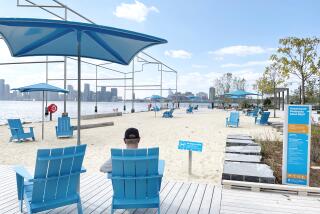New Jersey beach town struggles to recover from Sandy
- Share via
SEA BRIGHT, N.J. — The residents of Sea Bright returned home Friday, some for the first time since Superstorm Sandy, and attempted to salvage what they could from apartments and houses still inundated with sand and salty water.
Eleven days after the storm struck, seaside residents across New Jersey and New York continued their recovery-mode struggle, bedeviled with frustrating power outages, temporary housing and severe gasoline shortages that prompted New York rationing Friday.
In Sea Bright, about 50 miles south of New York City, the main thoroughfare through town, Ocean Avenue, had been cleared of about 5 feet of sand, and earth movers were still slogging away Friday clearing debris. New Jersey National Guard troops had set up tents in front of the fire station and were patrolling the streets, along with police and troopers from Alabama and Mississippi. The sound of power drills filled the air as business owners covered broken windows and doors with plywood. Gov. Chris Christie had visited earlier in the day to survey the damage.
On the north side of town, Jillian Rizzo, 26, pulled bundles of clothes from the closet of her ground-floor unit at Anchorage Apartments, where the floor was coated with sand, the refrigerator had been thrown on its back and water still filled the drawers.
“My fiance said I must be crazy to still want to live out here,” she said as she packed her car to go stay with her fiance’s parents in Freehold, N.J. “It’s a strong community, though. It’s just something you got to get over.”
Melissa Barnett, 23, works at a brokerage house in Jersey City but grew up coming to the beach clubs here and always wanted to live on the ocean. She had two good months at her apartment before the storm flooded it. Walking the streets Friday, taking pictures of the damage, Barnett said she and her roommate didn’t plan to return.
“They’re going to have to rebuild. All the things we came for are not here. Our apartment still smells like ocean — and not good ocean,” she said.
At least 100 buildings in town have been damaged, with officials rating them on a scale of 1 to 5, with 5 meaning condemnation.
“What did they rate yours?” a neighbor asked Fran Shults.
A 3 or 4, good enough to rebuild, said Shults, who was wearing donated boots and ill-fitting jeans, and had come to wash what was left of her wardrobe at a temporary laundromat in the Lowe’s parking lot.
She has lived in town since 1976, and the beach was a part of her life long before that. She saved baby-sitting money to eat at Harry’s lobster shack, where she had her “first real down-the-shore date” in 1966 with her future husband. Harry’s was the kind of place that never changed, down to that one booth with the cracked vinyl seat. Now it’s boarded up in ruins.
“I just hope these people in other towns, when they get their power back, they don’t forget about people in Sea Bright, Breezy Point, Belmar — all these little towns on the water,” she said.
In the New York City area, as gas rationing took effect, drivers confronted long lines.
At a Brooklyn gas station, police monitored two lines of about 40 cars while 50 other people stood at a pump set aside for walk-ups like Erika Bowden.
Bowden’s SUV was at half a tank. She had two children to drive to school and a job in the Bronx. Sure, she could take public transportation to work, but it would be a trek.
“It’s three hours, with three trains and two buses. Or 20 minutes to drive. So my choice is this,” she said of the three containers she brought to the station.
New York officials were unable to explain the delays in getting gas to the area.
“It’s hard to pin down,” said the city’s police commissioner, Raymond Kelly, who dropped by the Brooklyn gas station where Bowden was waiting Friday. “We’re still trying to figure out the details of where it is.”
New York Mayor Michael R. Bloomberg seemed similarly confounded that so few gas stations were operating — 30%, he said Friday. Officials cited storm damage to refineries and fuel terminals that may have delayed delivery of gas.
By midday Friday, the city and neighboring Nassau and Suffolk counties on Long Island were still adjusting to rationing.
Mick Ahmed, who runs a car service in Brooklyn, said his 15 drivers never knew when or where they’d be able to fill up. If they spotted an open station, they pulled in and waited, often for several hours. That, combined with the increase in people calling for cars because of disruptions in public transport, has made running his business “near impossible.”
“It’s murder,” said Ahmed, as he fielded calls from people trying to reserve vehicles and from drivers giving updates on open gas stations. At any given moment, one-fourth of his drivers were stuck in gas lines, he said.
“It’s a loss for everyone,” he said with a shrug. “But what are you gonna do?”
molly.hennessy-fiske@latimes.com
More to Read
Sign up for Essential California
The most important California stories and recommendations in your inbox every morning.
You may occasionally receive promotional content from the Los Angeles Times.















